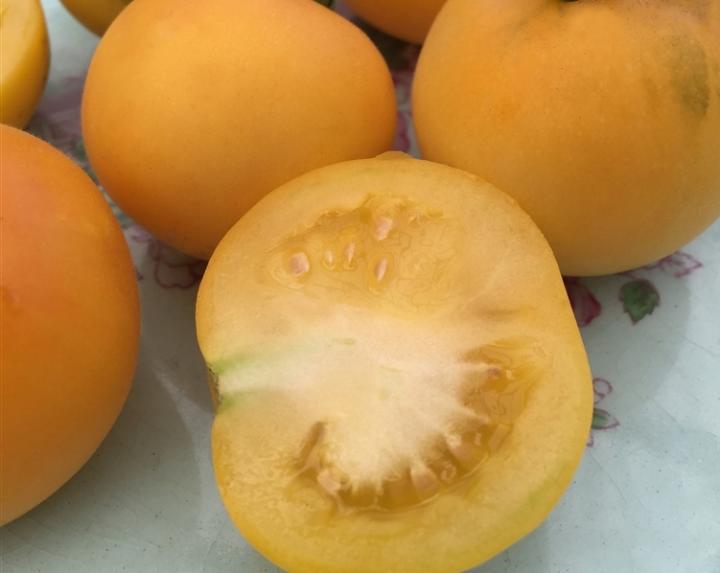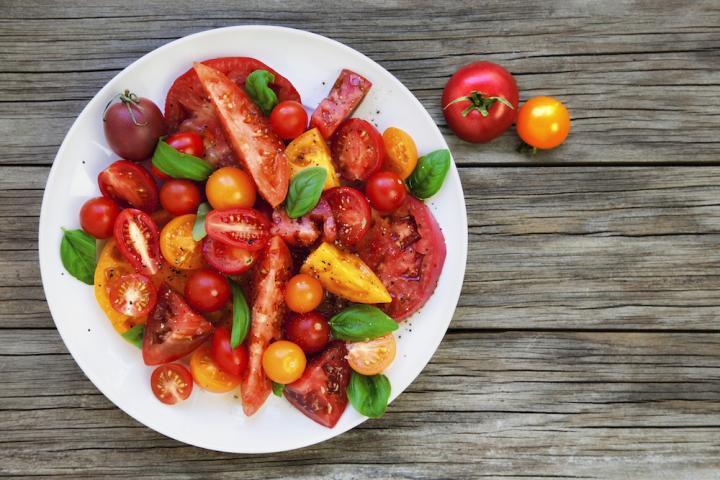Biologically speaking, tomatoes are fruits but why do we think of them as a vegetable? Let’s have fun with tomato trivia—plus my 10 tips and tricks on growing tomatoes successfully!
Whenever I mention that tomatoes are fruits, I also get the response: No, tomatoes are vegetables? In a sense, a tomato is both a fruit and a vegetable but let’s explore this age-old question.
Tomatoes as Fruits
Does a tomato have seeds? Of course, the answer is yes. If your edible garden crop has seeds, it’s fruit. Botanically, fruit is a ripened flower ovary and contains seeds.
Wait … does that means that pumpkins are fruit? And zucchinis? And cucumbers? Yes, botanically speaking, they are all fruit.
So, what’s a vegetable? Technically or botanically, if you just eat the stems or leaves or roots or flowers, that makes it a vegetable.
In other words, celery, lettuce, chard, beets, and broccoli are vegetables.
Tomatoes as Vegetables
Nutritionists, grocery stores, and even the government classifies tomatoes as vegetables. Just as we consider eggplant and peppers vegetables from a nutritional perspective.
Specifically, in 1893, the United States Supreme Court ruled that since tomatoes are most often served during the main part of the meal, either alone or with vegetables that tomatoes must be vegetables.
Fruit is used to describe sweet and fleshy fruits (think plums, peaches, grapes) that tend to be high in fructose. Sweet fruits are typically snacks or desserts.
So, why do we get hung up on tomatoes versus, say, zucchini? Perhaps it’s because they are rainbow-colored like fruit. They are also fleshy, similar to other botantical fruits. They’re certainly edible right out of the hand, similar to many botanical fruits. But tomatoes are certainly not treated as desserts. They’re served in salads, as a side dish, and in main meals.
Bottom-line, call a tomato a fruit or a vegetable—and you can be correct either way. Just enjoy the taste!
More Tomato Trivia
- The first wild tomatoes found by explorers in Mexico were yellow and small. Red, pink, black, green, ivory, white and bi-colors came later from the rampant mutation of tomatoes. Larger sizes and pleated and odd shapes appeared, too.
- The name “tomato” comes from the Aztec “xitomatl,” which means “plump thing with a navel”.
- When the tomato was introduced to Europe in the 1500s, the French called it “the apple of love.” The Germans called it “the apple of paradise.”
- But Europeans began to call them “poison apples.” Royalty used lead trenchers for tableware, and the acid of tomatoes sucked up the lead and sickened or killed regal diners! Poor people used wood trenchers and ate tomatoes with abandon, as they were plentiful and cheap. Tomatoes weren’t really embraced until the invention of the pizza in 1880 by the Italians.
- Note: Tomato leaves really ARE toxic. Never eat tomato leaves. Just eat the fruit.
- 93% American gardening households grow tomatoes.
- The tomato is the official state vegetable/fruit of Arkansas!

Image: Fuzzy, yellow Garden Peach tomatoes are genetically closer to the original wild tomato than are red ones.
10 Tomato Growing Tips and Tricks
- Plant the right tomato for your climate. Determinate or bush types produce their entire crop in a few weeks. They are perfect for short seasons. Indeterminates, or plants that keep on growing and producing until a killing freeze, do well in hotter climates with long growing seasons. Or plant both types. You’ll have a large harvest in mid-summer from determinates and a smaller, but steady supply of indeterminate tomatoes until frost.
- You MUST pick a growing spot with uninterrupted full sun. If you even have tree branches with leaves that will shade your plants for a couple hours a day, that could be a problem when the plant is growing leaves and floewrs.
- Don’t overdo the fertilizer, especially with fast-release fertilizers. Tomatoes produce best with slow-release fertilizers that deliver small amounts of nutrients continually. Fast-release fertilizers result in ten-foot plants and no tomatoes.
- Grow your homegrown fresh tomatoes without chemicals. Work compost into the soil before planting. Then, add a handful of bone meal or tomato fertilizer to the planting hole. Then, wait to apply an organic tomato fertilizer until after the fruit has formed. Apply a fertilizer like Espoma Tomato-tone every few weeks throughout the growing season. Just scratch a couple tablespoons around the dripline of the plant or “side dress” a row of plants. And you must water in to activate!
- Mulch plants thickly with straw, shredded leaves or any other organic matter. This keeps soil moisture even and prevents fungal spores, which spread diseases over plants, from splashing up from the soil on to plant foliage.
- Blossom-end rot is caused by inconsistent soil moisture, not lack of calcium in the ground. There is usually plenty of it in most soils, but calcium depends on water to transport it to plant roots. So, mulch heavily and deliver at least 1 inch of water to plants weekly.
- Withhold water for 3 to 4 days before harvesting. Tomatoes will be sweeter and more flavorful. Then water consistently and deeply! Do NOT let the soil dry out. Tomatoes are mostly water so it’s essential to keep the soil moist.
- Don’t refrigerate tomatoes for the best flavor. Pick the day you want to use them or harvest them slightly green, eating the tomatoes as they ripen.
- If you are planting in containers, make sure the pot is big enough. Go for 5 gallons or more, even if you don’t think you need it. Fill it with rich soil so they can spready out and gather all that nourishment for teir stems, leaves, flowers, and fruit.
- When killing freezes threaten, pick all the green tomatoes. Place them in a single layer in cardboard boxes and store in a warm, dry area. Tomatoes will ripen within two to three months, lengthening your harvest. Think home-grown tomatoes for Christmas!

Image: Use at least two colors for a fresh salad any gourmet would love. Credit: Getty Images.
- For an eye-catching gourmet salad, thinly slice three different colored tomatoes, arrange slices on a bed of leaf lettuce, strew with freshly sliced basil and crumbles of Feta cheese and drizzle with olive oil and wine vinegar.
See the Almanac’s free Tomato Growing Guide for information on planting, growing, and harvesting.













Comments